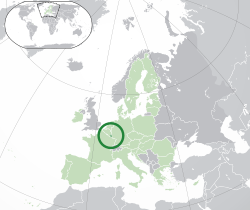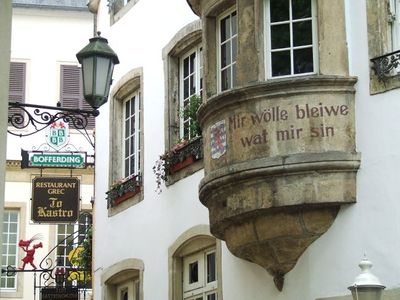Luxembourg: Difference between revisions
No edit summary |
No edit summary |
||
| (6 intermediate revisions by the same user not shown) | |||
| Line 16: | Line 16: | ||
}} | }} | ||
{{abr-50|Sept, 2024}} | {{abr-50|Sept, 2024}} | ||
'''Luxembourg''' (officially the Grand Duchy of Luxembourg) is a small landlocked country in western [[Europe]], bordered by [[Belgium]], [[France]], and [[Germany]]. Its population is about 480,000. Luxembourg is the capital and largest city. Luxembourg is a trilingual country; French, German, and Luxembourgish are official languages. | '''Luxembourg''' (officially the Grand Duchy of Luxembourg) is a small landlocked country in western [[Europe]], bordered by [[Belgium]], [[France]], and [[Germany]]. Its population is about 480,000. Luxembourg is the capital and largest city. Luxembourg is a trilingual country; French, German, and Luxembourgish are official languages. | ||
Its capital, Luxembourg City, is one of the four official capitals of the European Union (together with Brussels, Frankfurt, and Strasbourg) and the seat of the Court of Justice of the European Union, the highest judicial authority in the EU. Its culture, people, and languages are highly intertwined with its neighbors, making it a mixture of French and German cultures. Luxembourgish is the only national language of the Luxembourgish people, as defined by law. In addition to Luxembourgish, French and German are used in administrative and judicial matters; | Its capital, Luxembourg City, is one of the four official capitals of the European Union (together with Brussels, Frankfurt, and Strasbourg) and the seat of the Court of Justice of the European Union, the highest judicial authority in the EU. Its culture, people, and languages are highly intertwined with its neighbors, making it a mixture of French and German cultures. Luxembourgish is the only national language of the Luxembourgish people, as defined by law. In addition to Luxembourgish, French and German are used in administrative and judicial matters; Luxembourg's three languages are considered administrative languages. | ||
With an area of 2,586 square kilometers (998 sq mi), it is one of the smallest sovereign states in Europe. In 2019, Luxembourg had a population of 634,730, | With an area of 2,586 square kilometers (998 sq mi), it is one of the smallest sovereign states in Europe. In 2019, Luxembourg had a population of 634,730, making it one of the least populous countries in Europe, but by far, it has the highest population growth rate. Foreigners account for nearly half of Luxembourg's population. As a representative democracy with a constitutional monarch, it is headed by Grand Duke Henri and is the world's only remaining sovereign grand duchy. Luxembourg is a developed country, with an advanced economy and one of the world's highest GDP (PPP) per capita. The City of Luxembourg, with its old quarters and fortifications, was declared a UNESCO World Heritage Site in 1994 due to the exceptional preservation of the vast fortifications and the old city. | ||
== History== | == History== | ||
The history of Luxembourg is considered to have begun in 963, when Count Siegfried acquired a rocky promontory and its Roman-era fortifications known as Lucilinburhuc, "little castle", and the surrounding area from the Imperial Abbey of St. Maximin in nearby Trier.[18][19] Siegfried's descendants increased their territory through marriage, war, and vassal relations. At the end of the 13th century, the counts of Luxembourg reigned over a considerable territory. In 1308, Count of Luxembourg Henry VII became King of the Romans and later Holy Roman Emperor. The House of Luxembourg produced four Holy Roman Emperors during the High Middle Ages. In 1354, Charles IV elevated the County to the Duchy of Luxembourg. The duchy eventually became part of the Burgundian Circle and then one of the Seventeen Provinces of the Habsburg Netherlands. Over the centuries, the City and Fortress of Luxembourg, of great strategic importance situated between the Kingdom of France and the Habsburg territories, was gradually built up to be one of the most reputed fortifications in Europe. After belonging to both the France of Louis XIV and the Austria of Maria Theresa, Luxembourg became part of the First French Republic and Empire under Napoleon. | The history of Luxembourg is considered to have begun in 963, when Count Siegfried acquired a rocky promontory and its Roman-era fortifications known as Lucilinburhuc, "little castle", and the surrounding area from the Imperial Abbey of St. Maximin in nearby Trier.[18][19] Siegfried's descendants increased their territory through marriage, war, and vassal relations. At the end of the 13th century, the counts of Luxembourg reigned over a considerable territory. In 1308, Count of Luxembourg Henry VII became King of the Romans and later Holy Roman Emperor. The House of Luxembourg produced four Holy Roman Emperors during the High Middle Ages. In 1354, Charles IV elevated the County to the Duchy of Luxembourg. The duchy eventually became part of the Burgundian Circle and then one of the Seventeen Provinces of the Habsburg Netherlands. Over the centuries, the City and Fortress of Luxembourg, of great strategic importance situated between the Kingdom of France and the Habsburg territories, was gradually built up to be one of the most reputed fortifications in Europe. After belonging to both the France of Louis XIV and the [[Austria]] of Maria Theresa, Luxembourg became part of the First French Republic and Empire under Napoleon. | ||
The present-day state of Luxembourg first emerged at the Congress of Vienna in 1815. With its powerful fortress, the Grand Duchy became an independent state under the personal possession of William I of the Netherlands with a Prussian garrison to guard the city against another invasion from France. In 1839, following the turmoil of the Belgian Revolution, the purely French-speaking part of Luxembourg was ceded to Belgium and the Luxembourgish-speaking part (except the Arelerland, the area around Arlon) became what is the present state of Luxembourg. | The present-day state of Luxembourg first emerged at the Congress of Vienna in 1815. With its powerful fortress, the Grand Duchy became an independent state under the personal possession of William I of the Netherlands with a Prussian garrison to guard the city against another invasion from France. In 1839, following the turmoil of the Belgian Revolution, the purely French-speaking part of Luxembourg was ceded to [[Belgium]] and the Luxembourgish-speaking part (except the Arelerland, the area around Arlon) became what is the present state of Luxembourg. | ||
<gallery mode="packed" heights="200px" caption=""> | <gallery mode="packed" heights="200px" caption=""> | ||
Image:Luxembourg.jpg|Scene in Luxembourg with their motto "Mir wölle bleiwe wat mir sin" - "We want to remain what we are". | Image:Luxembourg.jpg|Scene in Luxembourg with their motto "Mir wölle bleiwe wat mir sin" - "We want to remain what we are". | ||
</gallery> | </gallery> | ||
== Luxembourgian spanking artists == | == Luxembourgian spanking and spanking artists == | ||
{{scp|0}} | |||
A Luxembourgian [[spanking artist]] is [[Barbossasdaughter]]. | A Luxembourgian [[spanking artist]] is [[Barbossasdaughter]]. | ||
| Line 40: | Line 39: | ||
== External links == | == External links == | ||
{{Cia-link}}{{bing-link}} | |||
{{wr}} | {{wr}} | ||
{{ | {{footer}}{{saloc}} | ||
Latest revision as of 18:47, 3 November 2024
| Grand Duchy of Luxembourg |
|
(and Luxembourg's largest city) |
Source information is available at [ Sources ] |
Luxembourg (officially the Grand Duchy of Luxembourg) is a small landlocked country in western Europe, bordered by Belgium, France, and Germany. Its population is about 480,000. Luxembourg is the capital and largest city. Luxembourg is a trilingual country; French, German, and Luxembourgish are official languages.
Its capital, Luxembourg City, is one of the four official capitals of the European Union (together with Brussels, Frankfurt, and Strasbourg) and the seat of the Court of Justice of the European Union, the highest judicial authority in the EU. Its culture, people, and languages are highly intertwined with its neighbors, making it a mixture of French and German cultures. Luxembourgish is the only national language of the Luxembourgish people, as defined by law. In addition to Luxembourgish, French and German are used in administrative and judicial matters; Luxembourg's three languages are considered administrative languages.
With an area of 2,586 square kilometers (998 sq mi), it is one of the smallest sovereign states in Europe. In 2019, Luxembourg had a population of 634,730, making it one of the least populous countries in Europe, but by far, it has the highest population growth rate. Foreigners account for nearly half of Luxembourg's population. As a representative democracy with a constitutional monarch, it is headed by Grand Duke Henri and is the world's only remaining sovereign grand duchy. Luxembourg is a developed country, with an advanced economy and one of the world's highest GDP (PPP) per capita. The City of Luxembourg, with its old quarters and fortifications, was declared a UNESCO World Heritage Site in 1994 due to the exceptional preservation of the vast fortifications and the old city.
History
The history of Luxembourg is considered to have begun in 963, when Count Siegfried acquired a rocky promontory and its Roman-era fortifications known as Lucilinburhuc, "little castle", and the surrounding area from the Imperial Abbey of St. Maximin in nearby Trier.[18][19] Siegfried's descendants increased their territory through marriage, war, and vassal relations. At the end of the 13th century, the counts of Luxembourg reigned over a considerable territory. In 1308, Count of Luxembourg Henry VII became King of the Romans and later Holy Roman Emperor. The House of Luxembourg produced four Holy Roman Emperors during the High Middle Ages. In 1354, Charles IV elevated the County to the Duchy of Luxembourg. The duchy eventually became part of the Burgundian Circle and then one of the Seventeen Provinces of the Habsburg Netherlands. Over the centuries, the City and Fortress of Luxembourg, of great strategic importance situated between the Kingdom of France and the Habsburg territories, was gradually built up to be one of the most reputed fortifications in Europe. After belonging to both the France of Louis XIV and the Austria of Maria Theresa, Luxembourg became part of the First French Republic and Empire under Napoleon.
The present-day state of Luxembourg first emerged at the Congress of Vienna in 1815. With its powerful fortress, the Grand Duchy became an independent state under the personal possession of William I of the Netherlands with a Prussian garrison to guard the city against another invasion from France. In 1839, following the turmoil of the Belgian Revolution, the purely French-speaking part of Luxembourg was ceded to Belgium and the Luxembourgish-speaking part (except the Arelerland, the area around Arlon) became what is the present state of Luxembourg.
Luxembourgian spanking and spanking artists
In the 20th century, school corporal punishment fell out of fashion and was gradually banned in many countries, a trend that continues until the present day.
As of May 2008, Luxembourg prohibits corporal punishment in schools.
A Luxembourgian spanking artist is Barbossasdaughter.
Prostitution in Luxembourg
- Prostitution in Luxembourg ↗ on Wikipedia
External links
- More information is available at [ Wikipedia:Luxembourg ]
Chat rooms • What links here • Copyright info • Contact information • Category:Root


